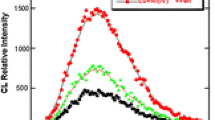Abstract
A sensitive and high selective chemiluminescence (CL) method was developed for the determination of lincomycin in acid medium using diperiodatonickelate as a reagent. The mechanism leading to luminescence is discussed by comparing the spectra of fluorescence and CL. Relative CL intensity is linear in the range from 8.0 ng mL−1 to 1.0 µg mL−1, the limit of detection is 2.5 ng mL−1 (3σ), and the relative standard deviation is 4.0% at 0.1 µg mL−1 of lincomycin (n = 7). The method was successfully applied to the determination of lincomycin in injections, human urine, and in serum samples.





Similar content being viewed by others
References
Moats WA (1991) Determination of lincomycin in milk and tissues by reversed-phase liquid chromatography. J Agric Food Chem 39:1812
Olšovská J, Jelínková M, Man P, Kobérská M, Janata J, Flieger M (2007) High-throughput quantification of lincomycin traces in fermentation broth of genetically modified Streptomyces spp. Comparison of ultra-performance liquid chromatography and high-performance liquid chromatography with UV detection. J Chromatogr A 1139:214
LaCourse WR, Dasenbrock CO (1999) Pulsed electrochemical detection of sulfur-containing antibiotics following high performance liquid chromatography. J Pharm Biomed Anal 19:239
Szúnyog J, Adams E, Liekens K, Roets E, Hoogmartens J (2002) Analysis of a formulation containing lincomycin and spectinomycin by liquid chromatography with pulsed electrochemical detection. J Pharm Biomed Anal 29:213
Douša M, Sikǎc Z, Halama M, Lemr K (2006) HPLC determination of lincomycin in premixes and feedstuffs with solid-phase extraction on HLB OASIS and LC–MS/MS confirmation. J Pharm Biomed Anal 40:981
Chiu MH, Yang HH, Liu CH, Zen JM (2009) Determination of lincomycin in urine and some foodstuffs by flow injection analysis coupled with liquid chromatography and electrochemical detection with a preanodized screen-printed carbon electrode. J Chromatogr B 877:991
Thomas ST, Donald KN, Jane C, Stephen FP (2003) Determination of lincomycin and tylosin residues in honey using solid-phase extraction and liquid chromatography-atmospheric pressure chemical ionization mass spectrometry. J Chromatogr A 1020:241
Sin DWM, Ho C, Wong YC, Ho SK, Alec CBI (2004) Simultaneous determination of lincomycin and virginiamycin M1 in swine muscle, liver and kidney by liquid chromatography-electrospray ionization tandem mass spectrometry. Anal Chim Acta 517:39
Fang XM, Feng LX, Ye JN (1996) Determination of lincomycin and lincomycin B in bulk drug and pharmaceutical formulations by capillary zone electrophoresis with amperometric detection. Anal Lett 29:1975
Yang WC, Yu AM, Chen HY (2001) Applications of a copper microparticle-modified carbon fiber microdisk array electrode for the simultaneous determination of aminoglycoside antibiotics by capillary electrophoresis. J Chromatogr A 905:309
Luo WH, Yin BZ, Ang CYW, Rushing L, Thompson HC Jr (1996) Determination of lincomycin residues in salmon tissues by gas chromatography with nitrogen-phosphorus detection. J Chromatogr B 687:405
Zhao X, You T, Qiu H, Yan J, Yang X, Wang E (2004) Electrochemiluminescence detection with integrated indium tin oxide electrode on electrophoretic microchip for direct bioanalysis of lincomycin in the urine. J Chromatogr B 810:137
Wang ZY, He YH, Nie F (2000) Determination of lincomycin hydrochloride by flow-injection chemiluminescence analysis. Chinese Journal of Analysis Laboratory 19:21
Mahesh RT, Pandurang DP, Sharanappa TN (2003) Kinetics and mechanism of oxidation of L-leucine by alkaline diperiodatonickelate(IV)-a free radical intervention, deamination, and decarboxylation. Monatsh Chem 134:1341
Abdulazizkhan LH, Mohammedsaleem RK, Sharanappa TN (2000) Kinetics and mechanism of the oxidation of 1, 10-phenanthroline by diperiodatonickelate (IV) in aqueous alkaline medium. Monatsh Chem 131:1129
Sanjeevagowda TP, Mahantesh AA, Abdulazizkhan LH (2008) Oxidative deamination and decarboxylation of L-Asparagine by the aqueous alkaline diperiodatonickelate (IV) Complex. J Solution Chem 37:1795
Shan JH, Qian J, Wang MG, Shen SG, Sun HW, Wang AZ (2004) Kinetics and mechanism of oxidation of butylene-glycol by dihydroxydiperiodatonickelate (IV) with spectrophotometry in alkaline media. Chem J Chinese U 25:95
Liu YH, Shang YJ, Li WP, Wang CH, Deng KL (2000) Study of the kinetics of acrylamide polymerization initiated by diperiodatonickelate (IV) periodate complex. Acta Poly Sin 2:235
Yang CY, Zhang ZJ, Wang JL (2009) A new luminol chemiluminescence reaction using a tetravalent nickel-periodate complex as the oxidant. Microchim Acta 167:91
Murthy CP, Sethuram B, Rao TN (1986) Oxidation by tetravalent nickel Part 1: Kinetics of electron transfer from some aliphatic alcohols to Ni (IV) in aqueous alkaline media. Z Phys Chem Leipzig 6: 1212
National Pharmacopoeia Committee (2005) Pharmacopoeia of the People’s Republic of China. Part II. Chemical Industry, Beijing, p 532
Thabaj KA, Chimatadar SA, Nandibewoor ST (2008) Dual mechanism of oxidation of DL-methionine by diperiodatoargentate (III) in aqueous alkaline medium (stopped flow technique). J Mol Struct 882:88
Author information
Authors and Affiliations
Corresponding author
Rights and permissions
About this article
Cite this article
Yang, C., Zhang, Z. & Shi, Z. A novel chemiluminescence reaction system for the determination of lincomycin with diperiodatonickelate(IV). Microchim Acta 168, 293–298 (2010). https://doi.org/10.1007/s00604-010-0293-5
Received:
Accepted:
Published:
Issue Date:
DOI: https://doi.org/10.1007/s00604-010-0293-5



